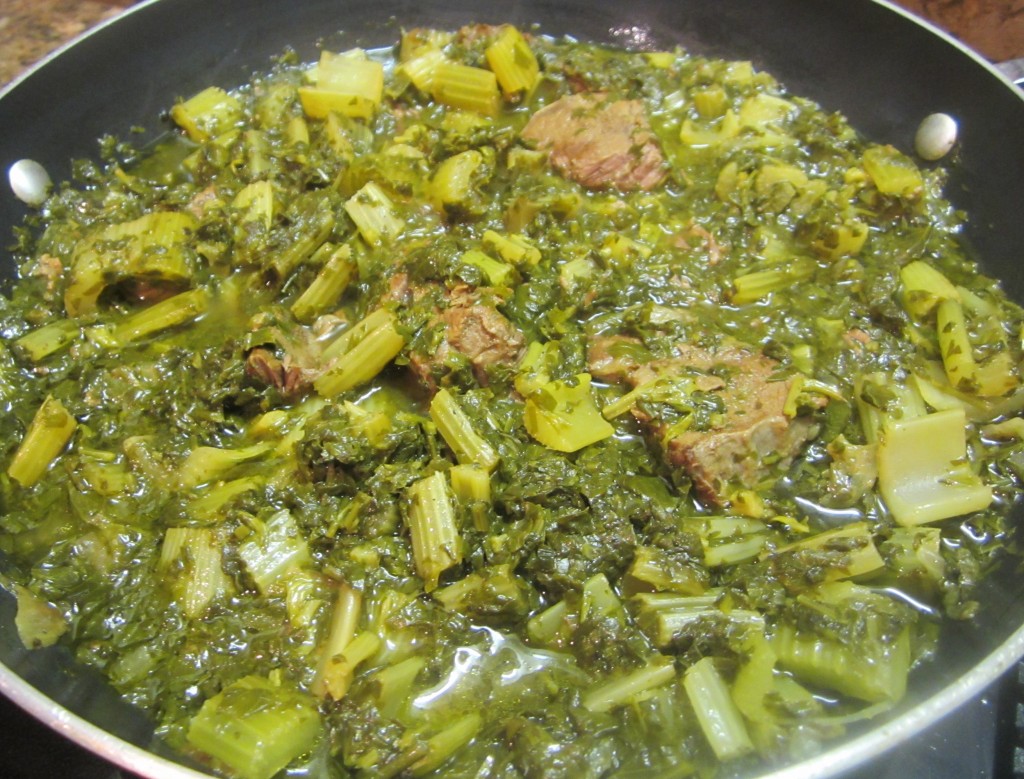The article below by Maryam Ala Amjadi on Iranian Cuisine was originally printed in the Tehran Times on September 4, 2011. Kindly note that the pictures and captions posted below did not appear in the original Tehran Times publication.
======================================================
An incredibly wise man and a passionate food lover once opined that if the divine creator has taken pains to give us delicious and exquisite things to eat, the least we can do is to prepare them well and serve them with ceremony. This axiom of festive spirit is perhaps the most evident feature that lies at the core of Iranian culinary.
Enriched with a colorful and yet a healthy diversity of dishes that are peculiar to various regions of this country, Iranian food is highly popular in the east and the west for its freshness and deliciousness. The Persian kitchen has the ability to retain its uniqueness by preparing meals within a range of subtle and yet contrasting flavors, such as a combination of sweet and sour or mild and rarely, spicy.
Generally, in Persian cooking food is not overpowered with spices. While herbs, spices and sometimes fruits are used for seasoning and garnishing, the flavors are quite subtle and delicate as in the design patterns of a Persian carpet. Persian cooking largely relies on rice as one of the main ingredients, which is an affordable and readily available staple in everyday diet. A typical Iranian meal is often a full plate of chelo (plain cooked rice) topped with vegetables, meat or fish. The mild flavor of rice provides a delightful contrast to the seasoned meat and vegetable toppings. Another staple food of Iran is naan (bread), typically a round, flat bread that can either be baked or cooked over a bed of small stones. While in villages, locals make their own naan, several varieties of fresh-from-the -oven bread is easily purchasable at naan shops in the cities. After lamb, which is Iran’s favorite meat, beef and chicken are commonly eaten in stews as well as in the form of the popular kabab (kebab) , which is actually meat grilled on a skewer. Fish is common as well, particularly in the North and the neighboring Caspian Sea towns where it is found fresh. In addition, there are a number of dishes prepared with a combination of herbs, grains, pulses, vegetables and even fruits. A bowl or platter of seasonal fresh fruits and dishes of herbs and vegetables which may be considered “exotic” (like dates and figs) in some other countries, are standard side dishes to most meals. They are also very creatively combined with meats in order to form flavored accessories to the main dishes. The dolma, for example, is one such dish. The term actually describes any vegetable or fruit stuffed with rice-meat mixture. The stuffed grape leaves are the most popular form of dolma. Today, Persian cuisine is gaining popularity in multicultural cities and cosmopolitan arenas, particularly Los Angeles, Vancouver, Washington D.C., Toronto and London. These cities have significant Iranian population. Some similar traits of Persian cookery can be found in the cuisines of a few other nations such as the Turks and the Greeks, mainly due to cultural and historical contacts among Iran and these nations. For instance, the kabab which is found worldwide today initially originated in Persia and was later on adopted by the Middle East and Turkey. There are of course many distinct features that set Iranian cuisine apart from other Middle Eastern food. First and foremost, Iran’s rich agriculture and diverse regional climates provide high quality food items and a natural wide diversity of herbs and vegetables. Iranian cookery, therefore, begins with high quality ingredients which preserve a strong natural taste, smell and texture. Secondly, most dishes are a work of art and delicacy and like other artistic works of this land, they are a little more time consuming in terms of preparation. Thirdly, the food is prepared fresh and served fresh. Fourth, less salt and oil are used in Iranian cooking as compared to other Middle Eastern cooking, a positive feature which makes Iranian cuisine, a healthy and hearty choice in one go. Moreover, side dishes shape a colorful panorama on the Iranian table. Spinach and yogurt, minced shallots in curd, lentil soup, a range of salads with olive oil and vinegar dressing, pickled fruits and vegetables peculiar to various regions of Iran are some of the side dishes that accompany the main edibles. Rising above the ingredients of Iranian cooking, one can claim that food is undoubtedly a fundamental part of the Persian heritage. Each item is a tasty representation of geographical aestheticism in a range of colors and scents specific to those regions. Eating is associated with a great deal of social events, as in births, funerals, weddings and many other rituals that convince us of the fact that culinary traditions are intertwined with Iran’s history, religion, culture and even literature. Some ingredients are even used as metaphors in Iranian poetry and prose: Honey colored eyes, peach colored complexion, laughing mouth like pistachio, pomegranate colored lips, hazelnut-like noses, red apple cheeks, almond-shaped eyes and many others. Deep dish delights at Persian Restaurants Even through economic slumps, restaurants in Iran are an ever growing industry. After cafés, they are the most popular hangouts for the Iranian youth particularly in the capital. Moreover, with their tradition setting and unique ambiance, they are also a compelling tourist attraction both inside and outside the country as they generally observe the standards of cleanliness and hygiene. Restaurants are majorly categorized by the type of dishes and services they provide. In a very typical and traditional restaurant, also known as sofreh khaaneh you can expect kabaabs done in a variety of styles: soft kababs, such as koobideh (minced meat kabab), pure meat kababs such as chenjeh (lamb chop kabab), bakhtiyari (a combination of roasted chicken and meat pieces on skewers) and a few others. These kababs as well as almost all stews are served with plain rice, side dishes and a popular yogurt based drink called doogh. Sofreh khaneh has flat wooden day beds with large cushions laid out for the diners to recline on as they eat. Sometimes the beds are laid out in a small garden. There are of course many restaurants that offer the same traditional food in the standard restaurant settings but for its relaxed and unique ambience, the sofreh khaneh continues to evolve into an even more popular place, where families and closed ones can bond over food. Modern Pizzerias face the Kabab Tradition The much younger generation, however, seems to have developed an increasing preference for fast food which has naturally resulted in the establishment of small and big fast food outlets, where one can usually find a variety of pizza, steak, hamburger, fried chicken etc. Known humorously as ‘keshloghmeh’ (elastic loaves), a modified Persian word, pizza done in an assortment of styles and flavors, continues to remain a very popular fast food dish among young Iranians. Despite the allure, however, the youth still know where to turn if they are, in the long run, looking for wholesomeness and deliciousness in one plate: the gastronomic charms of the traditional Persian platter. Restaurants serving traditional Iranian dishes, like the cholo kabab are still the most crowded and favored places. International cuisines are also currently in trend. Chinese, Japanese, Indian, Thai and Mexican food have become quite popular in recent years, primarily in Tehran. Facts about food and table manners in Iran Fork and spoon are the main pieces of cutlery used at the Iranian table. A knife is rarely used at lunch or dinner. When invited as a guest to lunch or dinner, expect to be offered second and even third helpings. Initial refusals will be assumed to be polite gestures (ta’arof, a sign of social decorum) and are taken mildly. Iranians usually eat a handful of herbs and greens along with their meals. Known as sabzi khordan (edible greens) these herbs are typically a combination of chives, spring onions, mint leaves, basil, tarragon, radish, parsley and dill, often along with handful of walnuts, naan and a piece of feta cheese. In most modern house settings food is eaten at the table but in a more traditional atmosphere, sofreh (table cloth like garment) available in a range of material and design pattern is spread on a Persian rug or table. Even in modern houses, some meals are still served on the floor and the sofreh is spread on the dining table. There are four major types of flat breads (naan) and about ten types of unflat and sweet breads available in various shapes and sizes in the art of Iranian bakery. Iranians revere bread to a great extent and do not discard or throw away stale bread along with other trash. Leftovers are usually disposed in separate containers. A practical way to refrain from unwanted disposal of bread was the formerly popular custom of trading dried bread for salt or fruit baskets with hawkers who roamed around for this purpose, a tradition that has been fading out, but still in practice in rural areas. Black tea is an all time beverage in Iran. It would not be an exaggeration to call it the national drink of the country. It is mostly drunk along with sugar cubes and on occasion with sweets. The sugar cubes are taken between the teeth and then the tea is sipped. Lunch and Dinner: Rice, white gold on the Iranian dining table Grown mostly in Iran’s northern Caspian provinces and prized mainly for its aroma, rice is indeed the jewel of Persian cuisine. What distinguishes Iranian rice dishes is the range of methods in which this ingredient can come to life in a Persian kitchen. Iranians consume rice daily in ways that somehow elevate it; sometimes it is as simple as boiling it in salt and oil and at times, it can be a ritual of running it half cooked through a sieve, throwing it back into the pot to fully steam and develop , then enriching it with a dash of saffron on the top and creating a golden crust (tahdig) at the bottom of the pot which comes out in different shapes and flavors, after the top of the pot is emptied and served, usually with a combination of another ingredient. The main typical Persian dishes are a blend of rice with meat, chicken or fish but rice can also be prepared as the main dish per se: On occasion, Persian rice dishes are richly studded with fruits, nuts, herbs and spices but more than often, rice is seen as an a companion to other dishes. The Khoresht-e Karafs (Picture Source: Mastering Persian Cooking). Another distinct feature in the tradition of rice eating as compared to rice eaters in the west that, when served with stew (khoresht) of either meat or chicken; rice is used as an edible bed where both items are mixed in proportion by the consumer before they are eaten. The two main national rice dishes are chelo and polo (white rice alone or with addition of meat and/or vegetables and herbs). 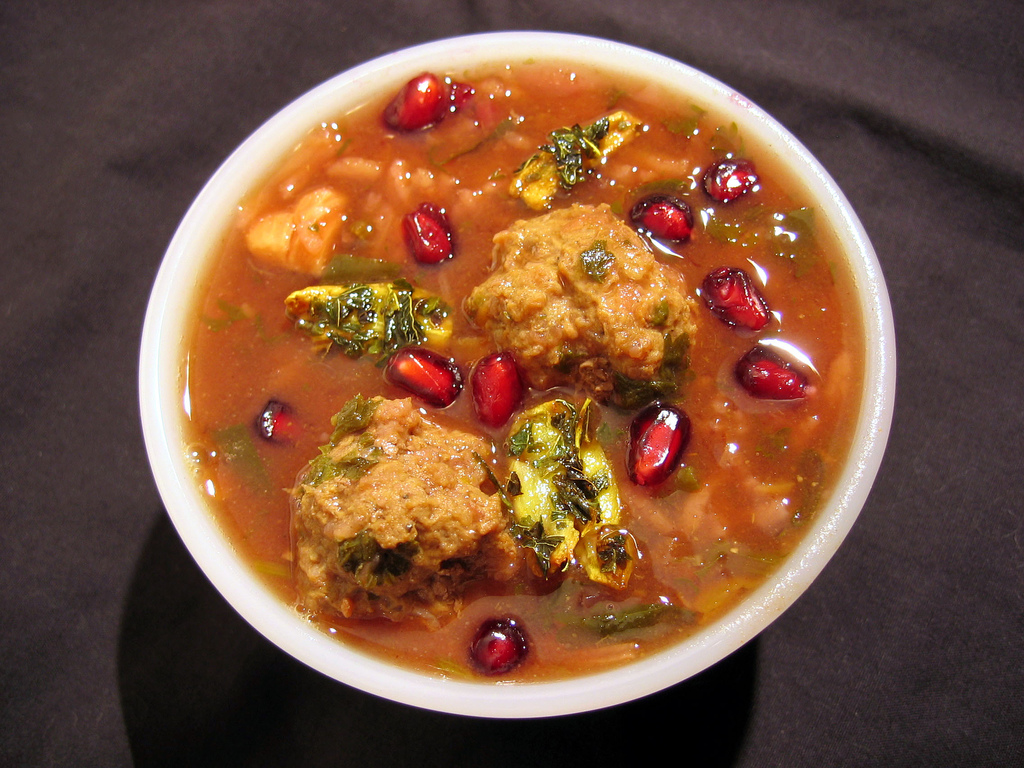
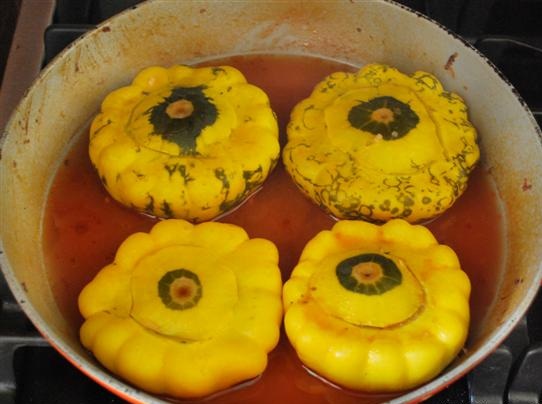 [Click to Enlarge] A vegetarian delight: the Dolmeh Kadoo (stuffed squash in the Persian style) (Picture Source: My Persian Kitchen).
[Click to Enlarge] A vegetarian delight: the Dolmeh Kadoo (stuffed squash in the Persian style) (Picture Source: My Persian Kitchen).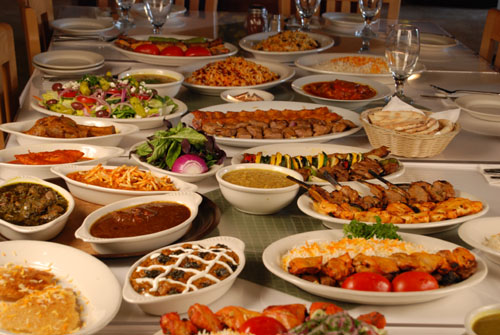 The diversity of Persian cuisine as displayed in the Ariana restaurant in London, England (Picture Source: Ariana Restaurant).
The diversity of Persian cuisine as displayed in the Ariana restaurant in London, England (Picture Source: Ariana Restaurant).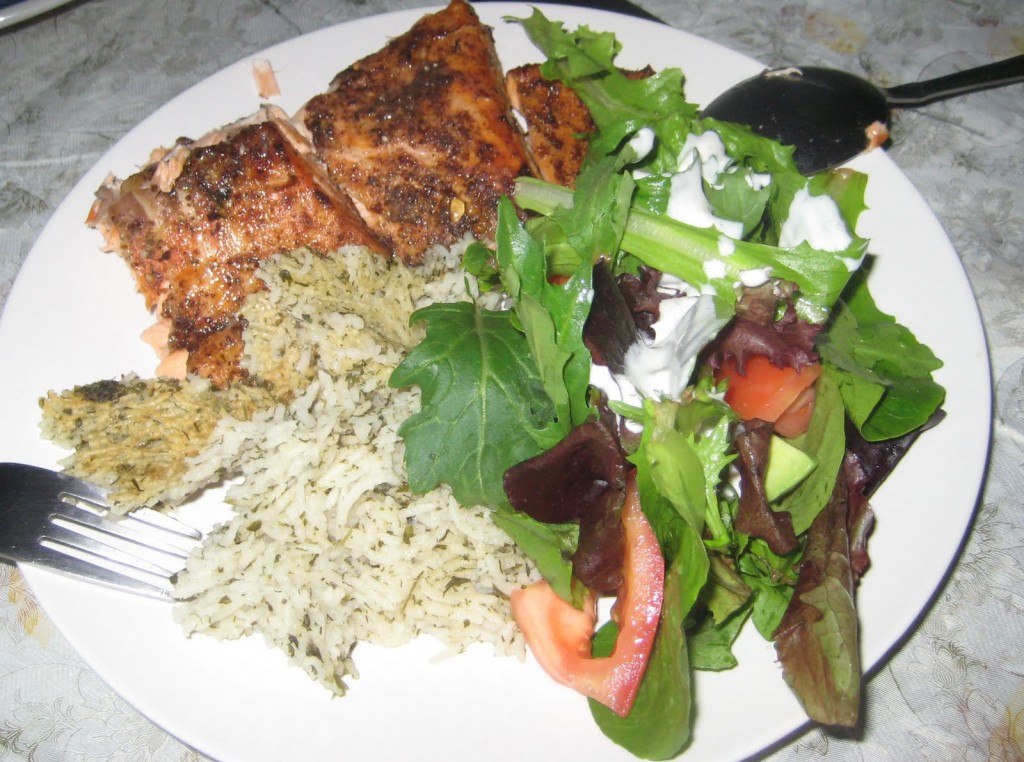 [Click to Enlarge] Sabzi-polo Mahi (vegetable-seasoned rice and north-Iranian style fish filet) (Picture Source: Phancouver).
[Click to Enlarge] Sabzi-polo Mahi (vegetable-seasoned rice and north-Iranian style fish filet) (Picture Source: Phancouver). 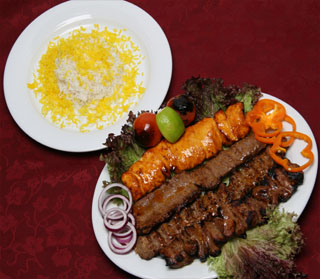 Mixed Koobideh, Barg and Joojeh Kabab skewers served with rice (Picture Source: Reza Restaurant); for more on this culinary art, see “Iran’s favorite dish: the Chelo Kebab“…
Mixed Koobideh, Barg and Joojeh Kabab skewers served with rice (Picture Source: Reza Restaurant); for more on this culinary art, see “Iran’s favorite dish: the Chelo Kebab“…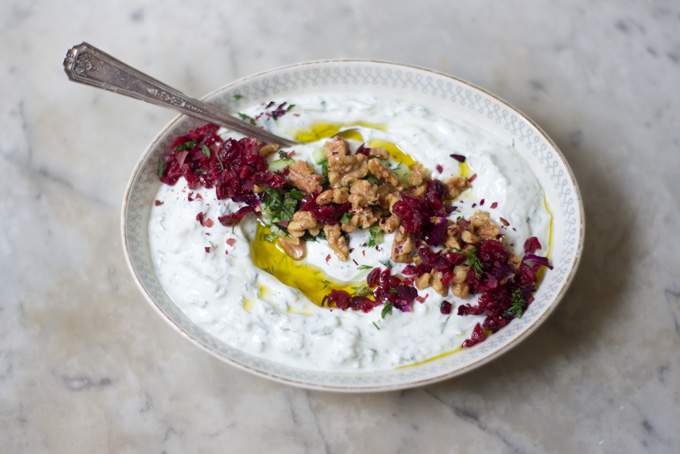 [Click to Enlarge] Persian appetizer (also a yoghurt-dip) called Maast-o Khiar which is a combination of cucumbers, raisins, walnuts, in a Persian-style yogurt (Picture Source: Debbie Ohi).
[Click to Enlarge] Persian appetizer (also a yoghurt-dip) called Maast-o Khiar which is a combination of cucumbers, raisins, walnuts, in a Persian-style yogurt (Picture Source: Debbie Ohi). 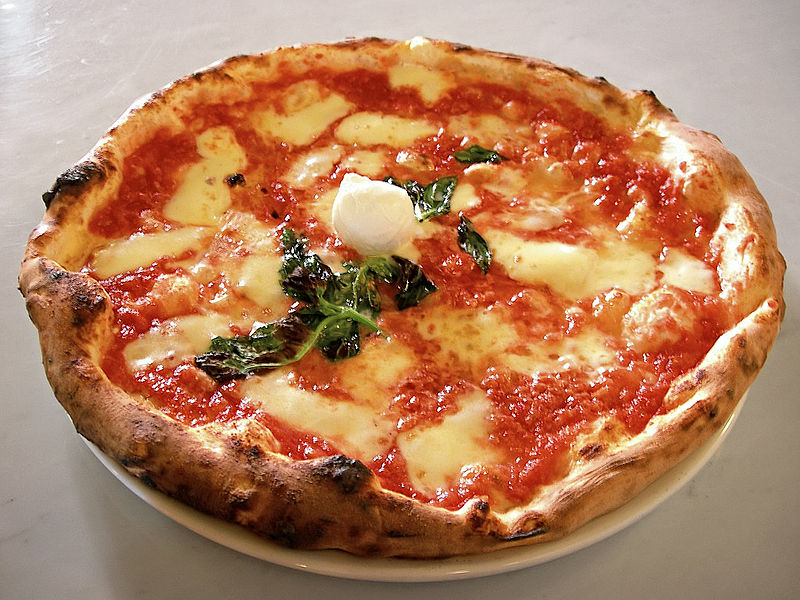 [Click to Enlarge] Persian-style “Pizza” from the eateries of Tehran (Picture Source: iFood.TV). There is fact a very large difference between the Persian Pizza and its classic Italian counterpart with respect to the base, toppings, etc. The “Persian Pizza” has become one of the most popular streets foods in Iran.
[Click to Enlarge] Persian-style “Pizza” from the eateries of Tehran (Picture Source: iFood.TV). There is fact a very large difference between the Persian Pizza and its classic Italian counterpart with respect to the base, toppings, etc. The “Persian Pizza” has become one of the most popular streets foods in Iran.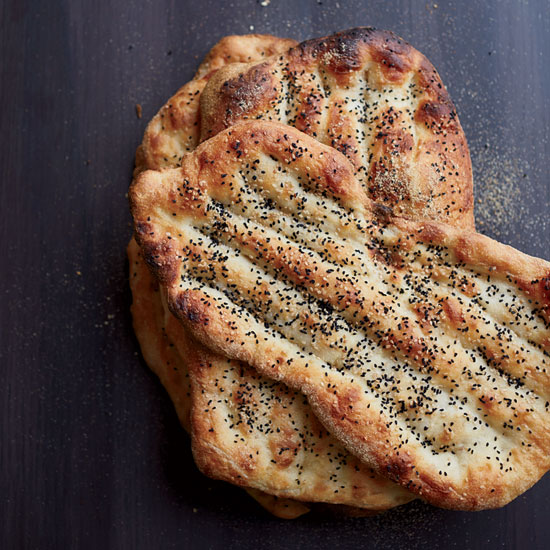 [Click to Enlarge] Naan-e Barbari (Picture Source: Food and Wine).
[Click to Enlarge] Naan-e Barbari (Picture Source: Food and Wine).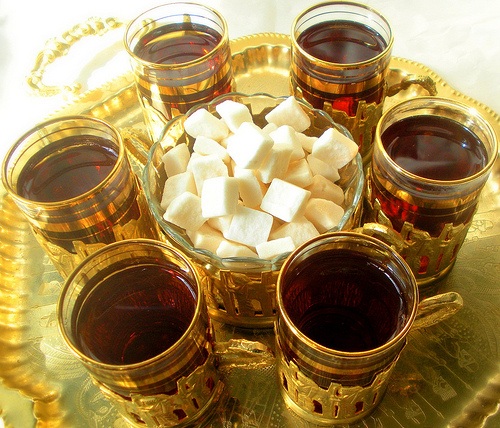 [Click to Enlarge] Traditional Persian Tea (Picture Source: Tumeric Saffron).
[Click to Enlarge] Traditional Persian Tea (Picture Source: Tumeric Saffron).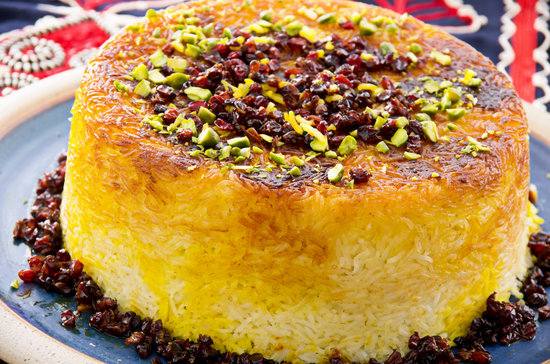 The Tahdig delicacy crust shaped around the rice in the form of a cake (Picture Source: YumSugar). There are in fact a large varieties of the Tahdig.
The Tahdig delicacy crust shaped around the rice in the form of a cake (Picture Source: YumSugar). There are in fact a large varieties of the Tahdig.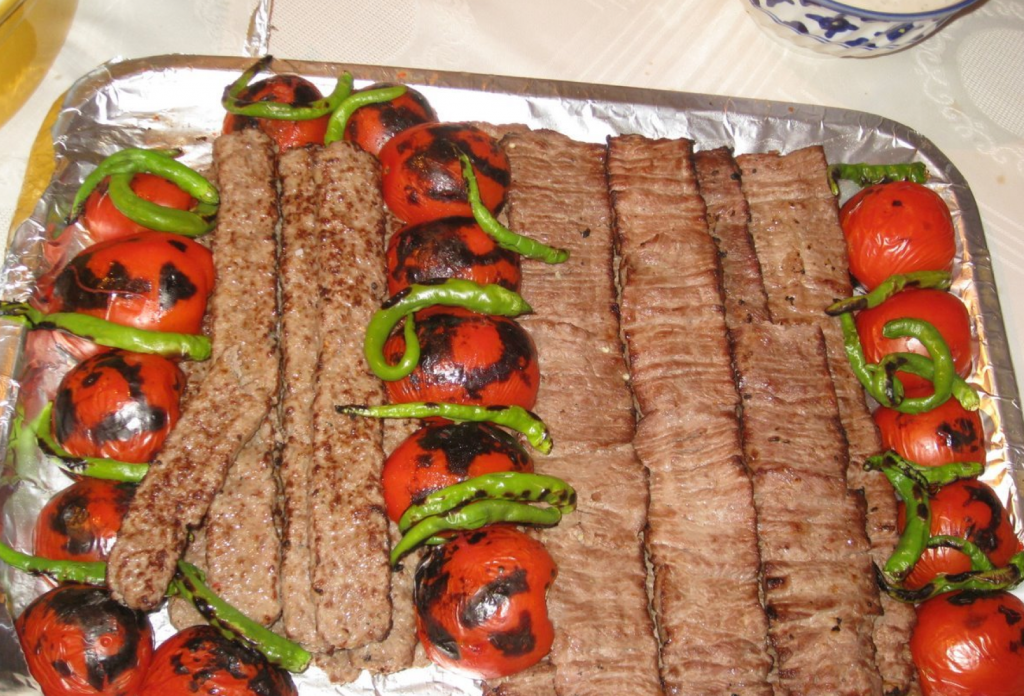 [Click to Enlarge] Serving of fresh skewers of Čelow-kabāb in the city of Tabriz, Iran’s Azarbaijan province (Picture Source: Payvand News). Tabriz is famous throughout Iran for its culinary style of the Čelow-kabāb dish and is also known for having popularized this throughout the country as well. There are still traditional restaurants in Tabriz that serve skewers almost a meter long! For more on the Čelow-kabāb culinary arts see “Iran’s favorite dish: the Chelo Kebab” …
[Click to Enlarge] Serving of fresh skewers of Čelow-kabāb in the city of Tabriz, Iran’s Azarbaijan province (Picture Source: Payvand News). Tabriz is famous throughout Iran for its culinary style of the Čelow-kabāb dish and is also known for having popularized this throughout the country as well. There are still traditional restaurants in Tabriz that serve skewers almost a meter long! For more on the Čelow-kabāb culinary arts see “Iran’s favorite dish: the Chelo Kebab” …
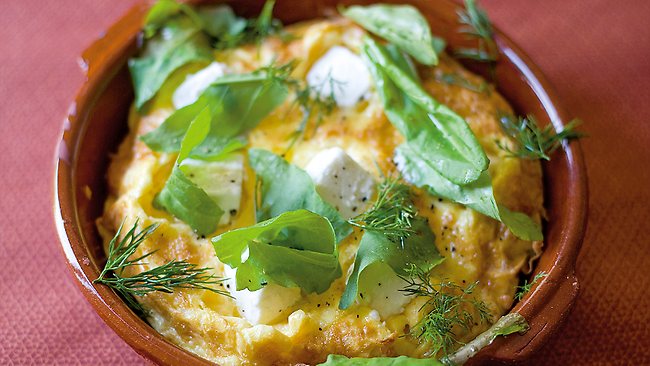 [Click to Enlarge] Traditional Persian Omelette (Picture Source: Herald Sun).
[Click to Enlarge] Traditional Persian Omelette (Picture Source: Herald Sun).

